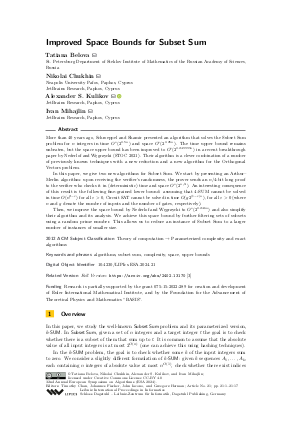Improved Space Bounds for Subset Sum
Authors
Tatiana Belova,
Nikolai Chukhin,
Alexander S. Kulikov  ,
Ivan Mihajlin
,
Ivan Mihajlin
-
Part of:
Volume:
32nd Annual European Symposium on Algorithms (ESA 2024)
Part of: Series: Leibniz International Proceedings in Informatics (LIPIcs)
Part of: Conference: European Symposium on Algorithms (ESA) - License:
 Creative Commons Attribution 4.0 International license
Creative Commons Attribution 4.0 International license
- Publication Date: 2024-09-23
File

PDF
LIPIcs.ESA.2024.21.pdf
- Filesize: 0.82 MB
- 17 pages
Document Identifiers
Related Versions
- Full Version https://arxiv.org/abs/2402.13170
Subject Classification
ACM Subject Classification
- Theory of computation → Parameterized complexity and exact algorithms
Keywords
- algorithms
- subset sum
- complexity
- space
- upper bounds
Metrics
- Access Statistics
-
Total Accesses (updated on a weekly basis)
0PDF Downloads0Metadata Views
Abstract
More than 40 years ago, Schroeppel and Shamir presented an algorithm that solves the Subset Sum problem for n integers in time O^*(2^{0.5n}) and space O^*(2^{0.25n}). The time upper bound remains unbeaten, but the space upper bound has been improved to O^*(2^{0.249999n}) in a recent breakthrough paper by Nederlof and Węgrzycki (STOC 2021). Their algorithm is a clever combination of a number of previously known techniques with a new reduction and a new algorithm for the Orthogonal Vectors problem.
In this paper, we give two new algorithms for Subset Sum. We start by presenting an Arthur-Merlin algorithm: upon receiving the verifier’s randomness, the prover sends an n/4-bit long proof to the verifier who checks it in (deterministic) time and space O^*(2^{n/4}). An interesting consequence of this result is the following fine-grained lower bound: assuming that 4-SUM cannot be solved in time O(n^{2-ε}) for all ε > 0, Circuit SAT cannot be solved in time O(g2^{(1-ε)n}), for all ε > 0 (where n and g denote the number of inputs and the number of gates, respectively).
Then, we improve the space bound by Nederlof and Węgrzycki to O^*(2^{0.246n}) and also simplify their algorithm and its analysis. We achieve this space bound by further filtering sets of subsets using a random prime number. This allows us to reduce an instance of Subset Sum to a larger number of instances of smaller size.
Cite As Get BibTex
Tatiana Belova, Nikolai Chukhin, Alexander S. Kulikov, and Ivan Mihajlin. Improved Space Bounds for Subset Sum. In 32nd Annual European Symposium on Algorithms (ESA 2024). Leibniz International Proceedings in Informatics (LIPIcs), Volume 308, pp. 21:1-21:17, Schloss Dagstuhl – Leibniz-Zentrum für Informatik (2024)
https://doi.org/10.4230/LIPIcs.ESA.2024.21
BibTex
@InProceedings{belova_et_al:LIPIcs.ESA.2024.21,
author = {Belova, Tatiana and Chukhin, Nikolai and Kulikov, Alexander S. and Mihajlin, Ivan},
title = {{Improved Space Bounds for Subset Sum}},
booktitle = {32nd Annual European Symposium on Algorithms (ESA 2024)},
pages = {21:1--21:17},
series = {Leibniz International Proceedings in Informatics (LIPIcs)},
ISBN = {978-3-95977-338-6},
ISSN = {1868-8969},
year = {2024},
volume = {308},
editor = {Chan, Timothy and Fischer, Johannes and Iacono, John and Herman, Grzegorz},
publisher = {Schloss Dagstuhl -- Leibniz-Zentrum f{\"u}r Informatik},
address = {Dagstuhl, Germany},
URL = {https://drops.dagstuhl.de/entities/document/10.4230/LIPIcs.ESA.2024.21},
URN = {urn:nbn:de:0030-drops-210925},
doi = {10.4230/LIPIcs.ESA.2024.21},
annote = {Keywords: algorithms, subset sum, complexity, space, upper bounds}
}
Author Details
- St. Petersburg Department of Steklov Institute of Mathematics of the Russian Academy of Sciences, Russia
Funding
Research is partially supported by the grant 075-15-2022-289 for creation and development of Euler International Mathematical Institute, and by the Foundation for the Advancement of Theoretical Physics and Mathematics "BASIS".
References
-
Shyan Akmal, Lijie Chen, Ce Jin, Malvika Raj, and Ryan Williams. Improved Merlin-Arthur protocols for central problems in fine-grained complexity. In ITCS, volume 215 of LIPIcs, pages 3:1-3:25. Schloss Dagstuhl - Leibniz-Zentrum für Informatik, 2022.

-
Noga Alon, Raphael Yuster, and Uri Zwick. Color-coding. J. ACM, 42(4):844-856, 1995.

-
Tatiana Belova, Nikolai Chukhin, Alexander S. Kulikov, and Ivan Mihajlin. Improved space bounds for subset sum. CoRR, abs/2402.13170, 2024.

-
Marco L. Carmosino, Jiawei Gao, Russell Impagliazzo, Ivan Mihajlin, Ramamohan Paturi, and Stefan Schneider. Nondeterministic extensions of the strong exponential time hypothesis and consequences for non-reducibility. In ITCS 2016, pages 261-270. ACM, 2016.

-
Timothy M. Chan. More logarithmic-factor speedups for 3sum, (median, +)-convolution, and some geometric 3sum-hard problems. ACM Trans. Algorithms, 16(1):7:1-7:23, 2020.

-
Xi Chen, Yaonan Jin, Tim Randolph, and Rocco A. Servedio. Subset sum in time 2^n/2/poly(n). In APPROX/RANDOM, volume 275 of LIPIcs, pages 39:1-39:18. Schloss Dagstuhl - Leibniz-Zentrum für Informatik, 2023.

- Ellis Horowitz and Sartaj Sahni. Computing partitions with applications to the knapsack problem. J. ACM, 21(2):277-292, 1974. URL: https://doi.org/10.1145/321812.321823.
-
Nick Howgrave-Graham and Antoine Joux. New generic algorithms for hard knapsacks. In Annual International Conference on the Theory and Applications of Cryptographic Techniques, pages 235-256. Springer, 2010.

-
Hamidreza Jahanjou, Eric Miles, and Emanuele Viola. Local reductions. In ICALP 2015, pages 749-760. Springer, 2015.

-
Hendrik W. Lenstra, Jr. and Carl Pomerance. Primality testing with gaussian periods. Journal of the European Mathematical Society, 21(4):1229-1269, 2019.

-
Andrea Lincoln, Virginia Vassilevska Williams, Joshua R. Wang, and R. Ryan Williams. Deterministic time-space trade-offs for k-SUM. In ICALP, volume 55 of LIPIcs, pages 58:1-58:14. Schloss Dagstuhl - Leibniz-Zentrum für Informatik, 2016.

-
Jesper Nederlof. A short note on Merlin-Arthur protocols for subset sum. Inf. Process. Lett., 118:15-16, 2017.

-
Jesper Nederlof and Karol Węgrzycki. Improving Schroeppel and Shamir’s algorithm for subset sum via orthogonal vectors. In STOC, pages 1670-1683. ACM, 2021.

- Nicholas Pippenger and Michael J. Fischer. Relations among complexity measures. J. ACM, 26(2):361-381, 1979. URL: https://doi.org/10.1145/322123.322138.
-
Richard Schroeppel and Adi Shamir. A T = O(2^n/2), S = O(2^n/4) algorithm for certain NP-complete problems. SIAM J. Comput., 10(3):456-464, 1981.

